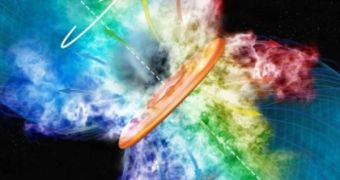Investigators at the Massachusetts Institute of Technology (MIT) Haystack Observatory announce that they were able to obtain new evidence on how massive stars, several hundred times the mass of our Sun, form. Though they only live for short periods of time, when considering the universal frame of reference, these stars play important roles in their nurseries, helping promote the development of other stars, and recycling their own materials when they die, PhysOrg reports.
During the new observations, the Haystack Observatory team discovered a huge disk of swirling gas enveloping a newly-formed, blue massive star. The finding is extremely important for astronomy, astrophysics and planetary sciences because it shows that the most massive stars in the Universe are actually formed through the same mechanisms employed by smaller ones, such as our own Sun. The new work could also help unravel some of the mysteries associated with the origin of life, as it’s a well-known fact that massive stars produce most of the heavy elements that are required for Earth-like planets to form, and evolve to a point where they become able to sustain complex life.
“It is the first really ironclad confirmation that massive young stars are surrounded by orbiting accretion disks, and the first strong suggestion that these disks launch magnetically driven winds,” explains Mark Krumholz, who is a professor of astronomy and astrophysics at the University of California in Santa Cruz (UCSC). The team also managed to develop a time-lapse movie showing the HO observations, which they detail in a scientific paper published in the January 1 issue of the renowned Astrophysical Journal.
The team used the Very Large Baseline Array (VLBA) telescopes for the new observations. There are ten antennas incorporated into the observatory, which together span the entire United States, and Hawaii. The new movie is a time-lapse sequence of images, which was collected through 19 photographs of the target between March 2001 and December 2002. “Full-motion movies are actually quite rare in astronomy. With a few exceptions, most processes take place much too slowly for noticeable changes to occur over a human lifetime,” the expert reveals.
The target of the VLBA study was the Source I (Source Eye) massive star, which is located about 1,350 light-years away, in the constellation Orion. Experts from the Harvard-Smithsonian Center for Astrophysics (CfA), the National Radio Astronomy Observatory (NRAO), and the Department of Physics at the University of Illinois in Urbana-Champaign (UIUC) also contributed to the investigation.

 14 DAY TRIAL //
14 DAY TRIAL //